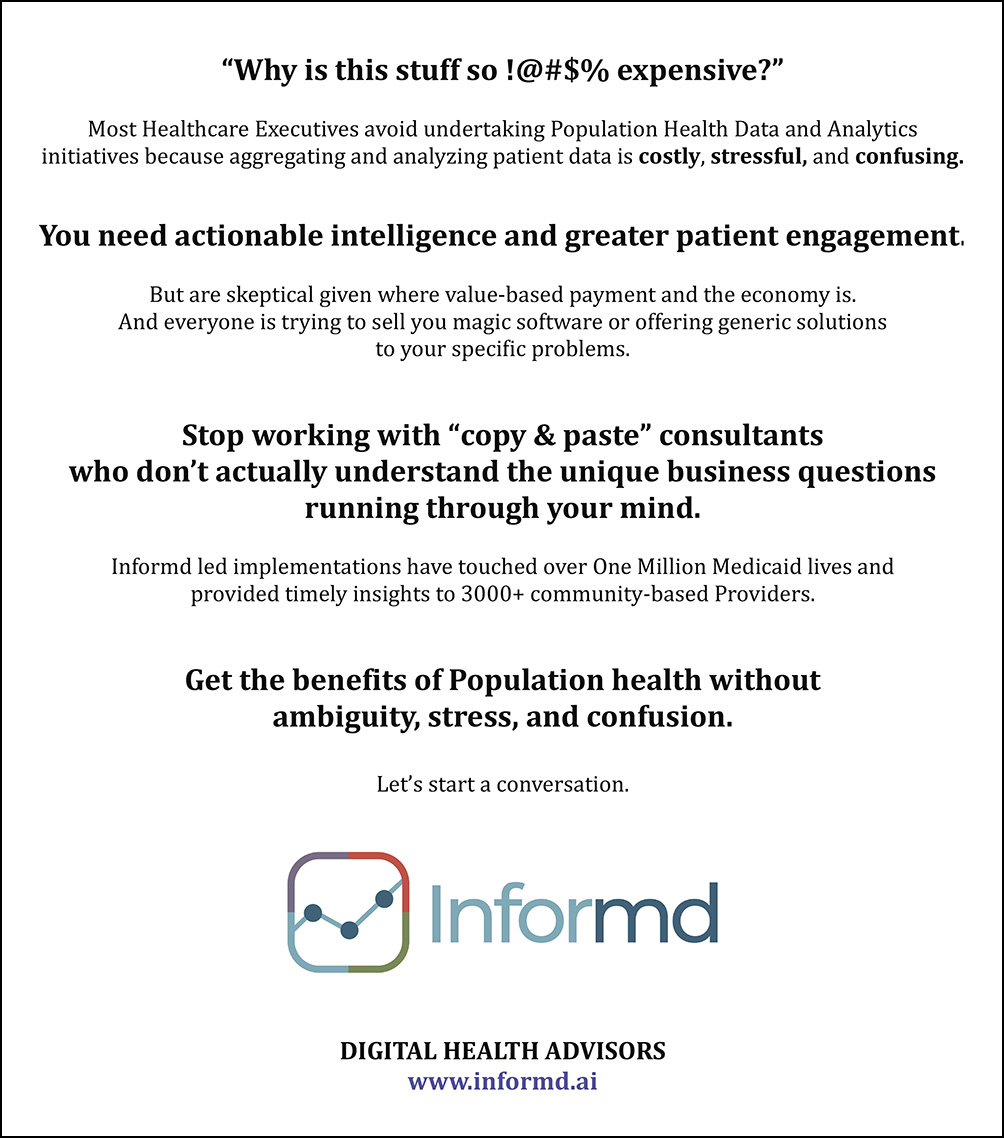AsOne Healthcare IPA launched the LEADS platform in February of this year, a first-of-its-kind IT and data solution to facilitate population health management and improve patient outcomes. LEADS was a collaborative effort: conceived by AsOne, developed by Netsmart Technologies, Inc. (Netsmart), and implemented by Informd. It is designed uniquely to aggregate data from all AsOne community-based network providers and other sources to enable the integration of services between members, quality improvement activity and the ability to track and monitor outcomes by family groups. Along with the electronic health records (EHR) of our network providers, LEADS also ingests from the New York State Health Information Exchange to provide historical data, real-time hospitalization alerts and COVID-testing alerts. LEADS houses actionable data on approximately 250,000 majority Medicaid lives.
The platform drives off of a Master Patient index (MPI) which merges unique clients from disparate patient records from different EHRs, different partners, and even different data sources, facilitating a 360 view of patients. This is key to clinical integration; with all the data driving directly from our partners’ databases and aggregated in one place, we can access a more complete and timely snapshot of a patient or a population’s status. In the future, we hope to connect to even more sources to improve the richness and completeness of our data.
Through this nearly two-year process, our IPA has worked through various challenges and identified opportunities and lessons learned that might benefit other networks /providers engaged in building and aggregating vast volumes of data from disparate sources for population health purposes.
Building the Platform Functionality
Quality work is a critical component of an effective network, and being able to calculate quality measures and report on performance data is a key feature of this platform. One of the main decisions in selecting metrics to include in the LEADS platform was differentiating between HEDIS, CMS, and other versions of measures. The HEDIS measures technical specifications drive off of claims data, requiring CPT Codes, ICD-10 codes, etc., while CMS metrics pull more from fields, fill data, and notes within EHRs. We considered whether to include the more widely-used HEDIS measures, which may not have as much data readily available to complete the measure, or CMS, which is slightly less standardized compared with MCOs and other payers but drives off of data that is more readily available from our partners. Weighing the needs of our network, we ultimately chose a combination of several HEDIS metrics and several CMS.
Viewing high-quality and timely data was also key for our network, so building functional and attractive dashboards to help interpret the data visually was a crucial piece of the platform. However, given the breadth and diversity of our services and network partners, it was a challenge to anticipate the various use cases for the dashboards. We brought together representatives from across the network to provide input on the dashboard configurations, functionalities, and features they would need to see to accomplish their own agency goals and support the goals of the AsOne network. We developed use cases before the dashboards were developed in order to ensure they met our intended purposes before being built.
Family Grouping: Innovation in Intergenerational Care
A key component of AsOne’s mission is to establish the family as the nexus for health, not only addressing the health and lives of one client or patient at a time but entire families at once, to break the cycle of co-occurring illness that often afflicts high-risk families and communities. We believe the healthcare system fails to adequately enable family-based approaches to treat patients with complex illnesses and co-morbid conditions. For example, Medicaid does not enroll family members on the same insurance plans and Managed Care Organizations (MCOs) do not group families together for treatment or cost analysis. Healthcare providers tend focus on one individual patient’s diagnosis and even if family are involved, it’s often only for decision-support.
AsOne believes the delivery system of the future takes a longer-term view to integrate behavioral health and primary care and involves the whole family. One of the challenges we aimed to solve with the launch of the LEADS platform was creating the infrastructure to support family-based models of care. Working with our Netsmart partners, we designed a novel functionality by which disparate members of our platform could be joined together into one “family.”
Developing this functionality led us to ask simple but difficult questions like what is the definition of “family”? For the purpose of platform function, we landed on a “family” revolving around one selected index patient and the social support network identified by that index patient, biological or not. Ultimately, we believe that this functionality is a crucial first step towards providing comprehensive intergenerational care, viewing outcomes by family units, and moving forward family-centric models of care.
Challenges in Data Exchange, Quality and Security
Pivoting to the build of the platform, which was a nearly two-year endeavor in collaboration with Netsmart and Informd, there were three key concepts that required significant discussion and thought. Data exchange, data quality, and data privacy and security.
Data Exchange
Data exchange generally involves writing technical code to extract data from a database, conforming or transforming that data to specifications understood by an application, and sharing (loading) that information to a location where the receiving database can ingest. There are two main schools of thought on how to best operationalize the data exchange flow – Extract Transform and Load (ELT), prioritizing quality vs. Extract Load and Transform (ETL), which prioritizes velocity.
Given the variety, velocity, and volume – the very definition of big data – of EHRs across the AsOne network, deciding which path to take was not something we contemplated lightly. Further complicating the choice was AsOne’s decision to pursue the entirety of each agencies’ EHR dataset rather than a narrow band selection of demographic and encounter information for measures. Our ambitions were to ingest all available data points that could be housed in our data warehouse including demographics, healthcare encounters, medications, screenings, and some social needs such as housing status. Case notes and other loose text was not included. The chief reason behind this pursuit of volume was to create a true longitudinal patient record encompassing all known information for our attribution and to avoid spinning subsequent data extraction initiatives, which would create fatigue for our network members and be resource intensive for AsOne.
In the end, we opted to provide choice to each organization on how best to operationalize a dataflow process so long as their core datasets conformed to a set of standards. This provided organizations with flexibility on the ‘how’ while providing AsOne with consistency on the ‘what.’ The Netsmart team recommended, and our IT committee approved, the CDC Public Health Information Network Vocabulary Access and Distribution System (PHIN VADS) code set as a network-wide data dictionary. Having a common standard across client, diagnosis, insurance, visit, laboratory, and medication data allowed us to harmonize and quantify our data in a manner that created consistency in ingestion and, more importantly, predictability in reporting.
Data Quality
Data quality is a journey, not a destination, something that was especially true as we required a continuous improvement mindset when dealing with the complexity and variation in our datasets. By creating lineage – the tracing of the information displayed on dashboards, to the algorithms that shape data into information and the initial extracts which brought that data into LEADS, we are able to quickly identify and address gaps in data. Even though we tried to ingest “everything” upfront from each of our partners, we still found some critical missing data variables during our validation efforts.
As an example, we found that some of AsOne’s selected quality measures required providers to explicitly label appropriate clinicians as “Mental Health Practitioners”, a categorical tag that was either missing or not ingested across our partners. By using the lineage process to map measure specifications to partner EMR submissions, we found specific taxonomy codes needed to be placed into the extract to appropriately activate the follow-up measures. This method significantly reduces the time from problem identification to solution, without the multi-layered steps traditional data gap efforts take.
Similarly, the way our partners collect, and record deceased data was not standardized, which presented a major area of concern for us. After all, what good is a population health platform if you can’t filter by patients who are still alive? Some of our partners reported “death” in the reason for discharge; others noted that a patient had died in the free text of progress notes which did not map to be ingested by our platform, and others recorded a properly formatted (and hopefully accurate) date. After surveying other colleagues in the field who reported similar challenges with deceased data but few solutions, we took an individualized approach with each partner to ensure dates of death were being captured and input into the correct EHR field which is then mapped to deceased status in LEADS.
While this approach may seem counterintuitive as we are taught to “measure twice and cut once” and scrutinize every data point before depositing it into a pristine data warehouse, without this ‘road less taken’ approach, most population health initiatives do not make it very far as it is impractical to examine every single variable prior to activation. AsOne focused instead on the vital few data sets important to the business today and not the many that we may need in the future. By highlighting the key functional areas of the LEADS platform useful to executives, clinical, and quality stakeholders today, we were able to prioritize data quality efforts in areas that had the largest value.
Data Security
A key functionality of a mature population health platform is the ability to reconcile disparate data points and link them back to an individual. The aspiration of AsOne in providing whole-person care requires blending primary care, mental health, substance use, hospitalization, and other datasets to create a composite record. However, this enhanced record cannot simply be shared with all AsOne partners, even when a treating relationship exists with more than one provider, due to HIPAA, 42 CFR Part II, state-based mental health laws and other regulatory rules which among many things, require blinding substance use-related data from those caregivers not specifically privileged to access that information.
To this end, undergirding the LEADS platform is the Master Patient Index (MPI) which not only unifies data but facilitates access rights. At the widest level is the AsOne perspective which can see the entirety of the patient records where duplicate patients’ records have the data merged together; at the narrowest level, is a single network partners’ view of their patients’ data merged with other external sources such as hospitalization data. Through this multi-tiered MPI, we can facilitate access to right driven views of the correct information to the specific provider(s) at the right time.
Knowledge Sharing for Improved Data
We believe that providers, networks and organizations working to aggregate, analyze and share data, should work to publish and share lessons learned and how to troubleshoot common and less-than common challenges. We were surprised at the vast obstacles and nuances we came up against during this process and leaned heavily on the AsOne and network member staffs’ experience and expertise in this field, legal and technical consultants, s and published best practices from other networks and organizations who had engaged in similar endeavors to offer guidance and a pathway forward through each challenge we encountered.
About AsOne
AsOne is a healthcare Independent Practice Association (IPA) that exists to facilitate value-based payment contracts with payers, including managed care organizations, on behalf of its clinically integrated provider network to provide health care and related social services. Currently, AsOne’s 19 network providers serve over 250,000 children, adults, and families with complex physical, mental, and social needs throughout the five boroughs of New York City. AsOne is one of several Behavioral Health Care Collaboratives that was launched and funded through the NYS Behavioral Health Value-Based Payment Readiness Grant, a multi-year initiative to help increase provider readiness to operate in value-based payment (VBP) environment.
Caroline Heindrichs, MA, is Executive Director at AsOne; Jawad Sartaj, MBA, is CEO of Informd; Jessica Frisco, RN, BSN, MPH, is Director of Quality and Compliance at AsOne; and McKenzie Pickett, MPH, is Manager of Program Operations, at AsOne Healthcare IPA.
For more information on AsOne Healthcare IPA, please visit www.myasone.org or send an email to McKenzie Pickett, Manager of Program Operations at AsOne at Mckenzie.Pickett@myasone.org.











